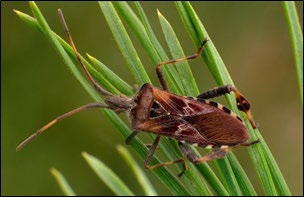PESTS AND DISEASES OF FORESTRY IN NEW ZEALAND
Insect Pests Affecting Douglas Fir in New Zealand and Overseas
Scion is the leading provider of forest-related knowledge in New Zealand
Formerly known as the Forest Research Institute, Scion has been a leader in research relating to forest health for over 50 years. The Rotorua-based Crown Research Institute continues to provide science that will protect all forests from damage caused by insect pests, pathogens and weeds. The information presented below arises from these research activities.
From Forest Health News.
In the previous issue (Forest Health News 265), it was mentioned there are a number of long-established exotic insect pests and native insects that can affect Douglas-fir in New Zealand.
Among the most commonly found caterpillars are the native loopers Pseudocoremia fenerata and P. suavis (Lepidoptera: Geometridae). P. suavis outbreaks were recorded in Kaingaroa in the 1970s, in association with the needle cast fungus Phaeocryptopus gaeumannii Other outbreaks have been recorded in Canterbury. These are worth mentioning, as they are probably some of the few known cases where large areas of exotic conifer forest in New Zealand have been defoliated by an insect.

Other native insects have been observed damaging leaves or tips, such as the brownheaded leafroller, Ctenopseustis obliquana, and the blacklegged leafroller, Planotortrix excessana, (Lepidoptera: Tortricidae), the forest semilooper Declana floccosa (Lepidoptera: Geometridae), and the bronze beetle Eucolapsis brunnea (Coleoptera: Chrysomelidae).
The native longhorn beetle Coptomma lineatum (Coleoptera: Cerambycidae) affects shoots and branches of larger Douglas-fir trees, causing the end of the branch to “flag”. Very occasionally it can result in malformed trees or trees with multiple leaders. Larval galleries in the branches can also extend in to the tree’s main stem, affecting sawn timber grading. Other native and long-time introduced longhorns Arhopalus ferus; Calliprason pallidus and Prionoplus reticularis (Coleoptera: Cerambycidae), bark beetles Hylastes ater; Hylurgus ligniperda; and wood borer Pachycotes peregrinus (Coleoptera: Curculionidae), as well as the native termites Kalotermes brouni (Isoptera: Kalotermitidae) and Stolotermes ruficeps (Isoptera: Termopsidae) are usually confined to dead and dying material.
Despite Douglas-fir plantations covering about 105,000 ha in New Zealand (essentially in Otago and Southland), there are currently very few introduced pests damaging these. The chalcid Megastigmus spermotrophus (Hymenoptera: Torymidae) had been established since the 1920s, and is now distributed throughout the country. Its effect on Douglas-fir seed-production is relatively limited with losses only locally exceeding 20% in certain years. In Europe, however, where M. spermotrophus had also been introduced, seed losses are higher and on occasion exceed 90%.

Current bans on Douglas-fir wood products, whole plants and cuttings help prevent future spread of most insect pests from their native area. However, several moderate to high importance pests may present a risk for New Zealand. Another seed-affecting invader, the western conifer seed bug Leptoglossus occidentalis (Hemiptera: Coreidae), has been highly successful in escaping its native area, and has colonised most of Europe and Japan over the last decade. Other potentially high impact invasive pests include the Douglas-fir cone moth Barbara colfaxiana and the western spruce budworm Choristoneura freemani (Lepidoptera: Tortricidae), the Douglas-fir tussock moth Orgyia pseudotsugata (Lepidoptera: Erebidae) and the Douglas-fir beetle Dendroctonus pseudotsugae (Coleoptera: Curculionidae).
Nicolas Meurisse
This information is intended for general interest only. It is not intended to be a substitute for specific specialist advice on any matter and should not be relied on for that purpose. Scion will not be liable for any direct, indirect, incidental, special, consequential or exemplary damages, loss of profits, or any other intangible losses that result from using the information provided on this site.
(Scion is the trading name of the New Zealand Forest Research Institute Limited.)



